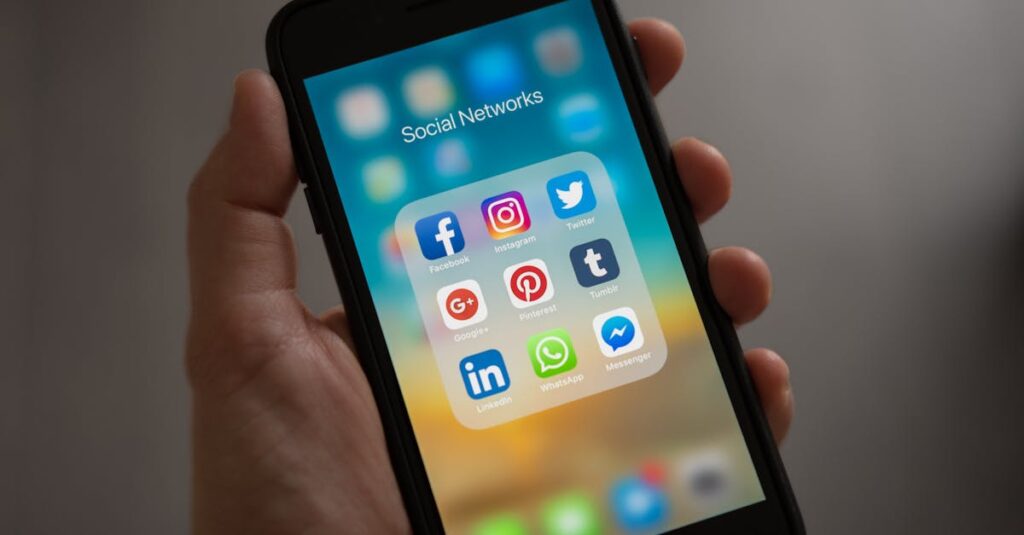Table of Contents
ToggleEver found yourself squinting at your iPhone screen like it’s trying to hide something? If so, you’re not alone! Many users struggle with the default screen size, wishing for a more manageable view that doesn’t strain their eyes. Thankfully, making that screen smaller isn’t rocket science—it’s just a few taps away.
Understanding Screen Size Adjustments
Adjusting the screen size on an iPhone enhances user experience and minimizes strain. Users can easily modify their display settings to suit personal preferences.
Importance of Screen Size
Screen size affects readability and comfort during extended use. A smaller screen can reduce eye strain significantly. Users find tasks like reading, browsing, and texting easier on a well-adjusted screen. Many individuals prefer a more compact view for better visibility of on-screen content without excessive scrolling. Altering the screen size contributes to a personalized experience that enhances overall satisfaction while using the device.
Accessibility Settings Overview
iPhone’s accessibility settings offer various options to customize screen size. Users access these features through the Settings app, enabling simple adjustments. Options include “Zoom,” which enhances specific sections of the screen, and “Display & Text Size,” allowing for font and size changes. Each setting allows for tailored solutions based on user needs. Utilizing these accessibility features ensures that all users can interact comfortably with their devices, regardless of visual challenges.
Methods to Make Screen Smaller on iPhone
Users can easily adjust their iPhone’s screen size through several methods. These options enhance readability and comfort for extended use.
Using Display Settings
Accessing the display settings allows users to modify the screen size effectively. Navigate to Settings, then choose Display & Brightness. From there, users can select Text Size to alter font size. Additionally, enable the Bold Text option for improved visibility. These adjustments help create a smaller feel while making text easier to read. Adjusting screen settings optimizes user experience, ensuring comfort throughout daily tasks.
Adjusting Zoom Levels
Zoom settings offer another way to manage the screen size. Users can find this option by going to Settings, then selecting Accessibility. Under Accessibility, tap on Zoom and toggle the switch to enable it. Users can adjust the zoom level by double-tapping with three fingers. This feature allows for precise control over the displayed content’s size, providing a tailored view for different needs. Employing zoom adjustments lets users minimize eye strain during activities like reading or browsing.
Using Accessibility Features
Accessibility features on the iPhone make it easy to customize screen size for improved readability. Users can benefit from several options, including Zoom and Display Accommodations.
Enabling Zoom Functionality
To enable the Zoom feature, navigate to Settings, tap Accessibility, then select Zoom. Users can toggle the zoom option to activate it. This functionality allows for adjusting the zoom level using a three-finger double-tap. Enhancements to visibility occur instantly, making text and images appear larger on the display. Users can adjust the zoom scale in the Zoom menu, tailoring it to their preference. Fine-tuning makes reading and navigating much easier, particularly for those with visual impairments.
Using Display Accommodations
Adjusting display accommodations enhances screen appearance significantly. In Settings, users can select Display & Text Size under Accessibility. Options like Bold Text improve legibility, while Increase Contrast can highlight text effectively. Users may also enable Reduce White Point to decrease screen brightness without sacrificing clarity. Modifications to these settings lead to more comfortable viewing, benefiting those who spend long hours on their devices. Customizing these factors makes reading and viewing content much more manageable.
Alternative Solutions
Users can explore various methods to further reduce their iPhone’s display size beyond built-in settings. These solutions enhance comfort and usability for many individuals.
Third-Party Apps
Numerous third-party apps offer screen size adjustments tailored to user preferences. Apps like “TinyScreen” or “Display Switch” provide customizable features that manipulate the iPhone’s display settings. Many of these applications enable users to create a smaller, more manageable screen view that suits their visual comfort. With intuitive interfaces, users can easily adjust settings for preferred app displays. Ultimately, these apps complement iPhone’s native features, providing additional flexibility in managing screen size.
Screen Protectors
Screen protectors can also influence the overall screen experience on an iPhone. Some protectors come with anti-glare or privacy features that effectively make the screen feel smaller and more manageable. These protectors absorb reflections, reducing strain caused by bright environments. Installing a matte-finish screen protector can provide a softer display surface, easing eye fatigue during prolonged use. By curbing glare, individuals may find their screens easier to read, facilitating better interactions with content.
Adjusting the screen size on an iPhone is a straightforward way to enhance comfort and readability. By utilizing built-in accessibility features and exploring third-party apps users can create a personalized viewing experience that minimizes eye strain. This simple adjustment can significantly improve daily interactions with the device making tasks like reading and browsing much easier. Embracing these options not only fosters better usability but also promotes a healthier relationship with technology. Whether it’s through adjusting text size or using innovative apps, finding the right screen size can transform the way users engage with their iPhones.




